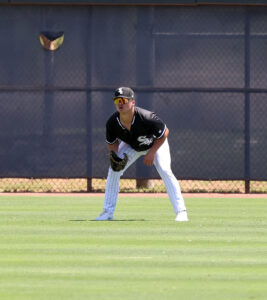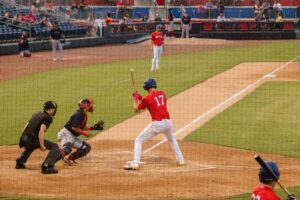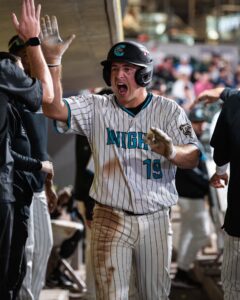Interviews with six Winston-Salem Dash prospects and a Pitching Coach
Last week I had the opportunity to cover the Winston-Salem Dash in person. We’ve already published a feature piece on Zack Burdi‘s debut in full season ball, and another covering a handful of other prospects we saw at BB&T Ballpark.
This article is the final post from that coverage – highlights from interviews with six Dash players and their Pitching Coach, Jose Bautista. We hope this will give our readers a view into some of the personalities behind the names of some of the team’s key players.

RHP Zack Burdi
Q: Now that you’ve joined the organization, have you spoken with the White Sox front office about your development path, and where that may lead this year?
A: Yeah, we’ve talked about it a little bit, and the possible steps both good and bad. I think we’re prepared to take one way if everything goes right, and take another way if it goes wrong. But for right now I’m just focused on playing good baseball, going out there and having solid innings, and doing what I can to help the team here.
Q: Has there been any mention or discussion of the potential for you to be in the majors this year?
A: No, they haven’t really put that on me, and haven’t heard that from anyone in the organization. But it’s definitely out there, people are whispering about it, I see people talking about it. But nothing from the front office.
Q: So you’re a reliever right now, but is there any chance for you to start again, maybe a desire of yours or something the organization has said or discussed with you?
A: Yeah, we talked about it when I got drafted. They said that they see me as a reliever, and that there is a possibility I’m going to start. But for now, at least for this season, I’m going to be a reliever. Then going into the spring next year they can re-evaluate that if they want to. But they drafted me as a reliever, and that’s what I’m going to be for right now.
Q: Describe for us the draft and signing process you went through, as it’s a little different for everyone. For example did you know the Sox were looking at you beforehand, etc.
A: I had a pretty good idea that the Sox at 26 and Baltimore at 27 had a good eye on me, and that if I fell to that spot there was a good chance that’s where I’d go. So it’s a testament to my agent, he did a really good job communicating that with me. But that night being drafted was awesome, with my family, and had four other teammates get drafted. So a really cool night. Then after the [collegiate] playoffs, went through the signing, went to the AZL for a couple days, then got here yesterday.
Q: You grew up in Downer’s Grove, went to DG South High School, and our fans will want to know this. White Sox or Cubs fan growing up?
A: White Sox.
Q: Last question – do you have anything in particular you are focused on or trying to improve right now?
A: Just good command, having good control of the game. Just slowing the game down. It’s a different speed than college, obviously, all the guys are top caliber dudes. So just getting a grip on that, taking my game out there having it work.

RHP Jordan Stephens
Q: You skipped not only past Low-A Kannapolis, you also came to High-A from a typically younger development league in the AZL, which is a pretty big leap to the Carolina League. What stands out in that difference, for you?
A: People ask me that a lot, and I compare it to a higher-end D-I college program. Everyone here has a plan. Everyone has an approach here, whereas in AZL everyone just swings away at anything you throw, strike or ball. So here, once you can figure out who has what plan, you can make it a lot easier on yourself.
Q: This is your first full season if pitching since your Tommy John surgery in 2014. Are you doing anything differently than a starter might otherwise, due to that surgery? Or do you feel that’s a non-factor now?
A: I don’t think it’s a consideration. We did a really good job with my rehab, Rice and my doctor. I actually came back throwing a little harder, so that was good. Right before TJ I was probably 89-92, now I’m sitting around [ninety] three and even getting up to [ninety] five, so that’s good.
Q: What’s changed for you in 2016? Any changes to your repertoire or delivery so far?
A: Yeah we changed a few things. We eliminating the first pause I did in my wind-up. A lot of people pointed it out, and we finally decided we needed to change it up. I’ve also moved to the center of mound, instead of the first base side. That helps me with my curveball. I can throw it arm-side all day long but couldn’t really get it all the way across. But I moved over to the middle where I can get out there further with it. Since I’ve changed those, I think five innings is the least I’ve gone and I’ve had mostly quality starts. Oh and then we just implemented the 2-seamer a couple starts ago.
Q: Speaking of that new 2-seamer, what situations are you using it in?
A: I mainly just use it against lefties, because with righties I don’t want it to go back down into the zone. I just start it low and middle and let it run off. I’ll try to use it when I need a ground ball, when there’s a guy at first… I use it a lot now. I’m also focused on my slider right now development-wise, almost forcing it in so I can get it where I want it.

RHP Thad Lowry
Q: You’ve had a really strong June, possibly the best month of your pro career. What do you think has changed or improved to make it all click lately?
A: Probably just staying on top of the ball, staying tall with my slider. But there was actually a rumor going around that I was tipping my pitches very badly, doing different things with my hands, so we fixed that. Certain things that the pitching coaches worked on, like holding the ball closer and gripping it harder. It’s all part of how I pitch now.
Q: Some people say there isn’t a lot of difference between Low A and High A. What differences, if any, do you see in the hitters you are facing here in the Carolina League, versus the Sally last year?
A: Batters here have more power. You’re not going to get away with a high fastball here. Maybe one of them, but the second one, these guys are powerful and they’re going to make you pay for it. They are more selective too.
Q: In high school, you were also a catcher, correct?
A: Yeah, basically up until senior year of high school, I was geared up to be a college catcher. I was ready to go to Texas Tech, possibly as a two-way player, maybe catch here and there, and be a Sunday starter or something.
Q: Since we won’t get to see you pitch in person on this trip, can you describe your pitch repertoire as it stands today, especially your secondary pitches, from your perspective?
A: Well, sometimes it’s up in the air, with the change or the slider that day. Lately this month, my change-up hasn’t been as effective because I’ve been leaving it up and it’ll get hit. But then my slider might be a lot better on a certain day.

Pitching Coach Jose Bautista
Q: When you are analyzing your pitchers, do you use any technology? Do you use tape much, or just eye ball it live?
A: OK well first, I pretty much let it go the first few weeks, see what they are doing wrong and what they are doing good, and go from there. Some of those guys don’t visualize it – it’s feel. So some guys, I’ll take them in to watch the videos. But some of them I just take them out to do their work, like when you saw me earlier with [Connor Walsh and Jacob Morris].
Q: Speaking of tape, at this level, do you or your pitchers ever look at tape of opposing hitters you’ll be facing to prepare for games? Do the catchers?
A: No, I have some notes I kind of use, that I’ll share. So like with the pitcher today, Adams, I’ll go over with him how we want to pitch these guys, how to throw them. But you can’t always say “oh, you have to start this guy with a breaking ball because he swings at the first pitch”, sometimes you do. Just basic things right now.
Q: I’m going to ask about a couple specific pitchers – first is Matt Cooper, who just got promoted to Birmingham. He did well as a reliever in Kannapolis last year, but now all of a sudden he went into the rotation and he’s leading all of Minor League Baseball in strikeouts. What changed in the last year? Or was the stuff always there?
A: For Coop, the stuff was there. We were working him out of the bullpen, but he was always asking me if he could start. This year in Spring Training we talked about it, and decided to put him in the rotation. We had a meeting with the other guys and decided on that. He showed four pitches that he can put in the zone. His fastball has some really good angle, his curve is pretty much 12-6, and he’s got a slider and a change-up. All four of those pitches he can throw for a strike from the same spot. Being able to do that is really good for a starter.
Q: We heard he’s headed for the bullpen in AA, at least for now. Do you see him as a starter or a reliever?
A: I think a long reliever, maybe in the middle. Not really quite a starter, I don’t think. But he could be a 5th or 6th or 7th inning guy or a long reliever, or a spot starter. He can do that.
Q: Now on a different pitcher, Spencer Adams, who is starting today. Spencer was throwing pretty hard in his draft year, mid 90’s with his fastball. Then in 2015 as he adjusted to full season ball, his velocity dropped quite a bit. Do you think he just needs to stay in that lower band to be more effective? Do you think he’ll get back to that level of velocity at some point?
A: So right now for him, it’s more to stay in the zone. You don’t try to over-do it. Sometimes, I’ll see him, he’ll try to throw hard and hit 94, 95. But right now, if you see it [tonight], he uses a lot of sinkers. He’s got a 4-seamer, around 92, that he uses when he’s behind in the count. But he uses that sinker a lot, and he’s got a really good slider.

OF Mason Robbins
Q: You are making good contact, and hitting for average, despite almost never walking [3 BB in 230+ PA]. How are you working the pitchers in such a way that you can do make that unusual combination hold? And is it something you are looking to change?
A: It’s kind of a curse at times. I can hit a lot of pitches, but it kind of hurts me. I think, If I walk more, I could have better stats than I already do. I had a talk with my coach about this the other day. Not so much trying to walk more, but shorten up my strike zone, and hit better pitches. I get kinda hit-happy a lot of times, because I think I can hit anything. Being up here, pitchers are a lot more in the zone than they were down in Low A, so I’m getting a lot more pitches to hit.
Q: Despite the fact that a stopwatch says you have lots of speed, you don’t really attempt to steal any bases. Is that a function of your own comfort level, or something the coaches don’t want you to do yet, or something else? Do you see it as a future part of your game?
A: Yeah, I think I’ve only even attempted to steal twice this year. As far as running the bases, not just stealing-wise, I think that’s something each player has to put on themselves. As far as the coaches go, it’s not something we’ve talked about. It is something I need to work on though, because that can help you out at the higher levels if you’re a fast guy. I mean, I’m pretty fast, but it’s different stealing bases as opposed to just being fast. Stealing bases is more of an art, to be good at it. You watch Adam Engel, he’s good at that, but he’s super-fast too.

RHP Danny Dopico
Q: You (like your teammate Jordan Stephens) skipped Low A to come to High A. You struggled out of the gate, but have really turned it around in the last month or two. What’s changed?
A: My problem at the beginning was trying to do too much, and not letting my stuff do the work for me. So in the last month it was more trusting my stuff. And when I stay quiet and sound with my delivery, that’s when I’m able to command it better. When I try to do too much, that’s when I hurt myself.
Q: Going from the Pioneer League to the Carolina League, which is a big leap, in what way are the hitters here different?
A: They’re definitely more disciplined, don’t chase as much. So you have to show them you can locate before you get those swings and misses. It’s really them being more patient. And in hitter’s counts you can’t really miss your spots or they’ll hurt you.
Q: In your approach to pitching, do you have a game plan you like to go in with? So, when you’re in the bullpen warming up or getting ready, do you formulate a plan then, or is it always the same?
A: My thought process is really just to attack the hitter, and be really aggressive in the zone. When you get a head, that’s when you can start messing around and try to get those swings and misses. Pretty much just going right after hitters.

OF Hunter Jones
Q: You just recently went to the Carolina League All Star Game. What was that experience like?
A: Very exciting, one I won’t forget. I had family and friends there who hadn’t seen me play in a while, since 2010 when I got drafted out of high school in Southern California. So it was great seeing them, it was just a lot of fun.
Q: You’re obviously a prolific base-stealer, and you certainly have speed. But what about your technique? Can you walk us through what you think you do to succeed on the basepaths?
A: Definitely starts in the dugout, where you pick up [the pitcher’s] tendencies when you watch him. Maybe you write it down for the next time. You’re stealing off the pitcher. Also, get a nice big, comfortable lead, stay in your legs, in a nice athletic position. Sometimes it can be tough, but it’s a mindset, you have to be aggressive. You just go.
Q: Anything development-wise you’re focused on improving right now?
A: Staying consistent, getting on base. Seeing good pitches to hit, getting on, stealing, scoring runs.
Want to know right away when we publish a new article? Type your email address in the box and click the “create subscription” button. Our list is completely spam free, and you can opt out at any time.




